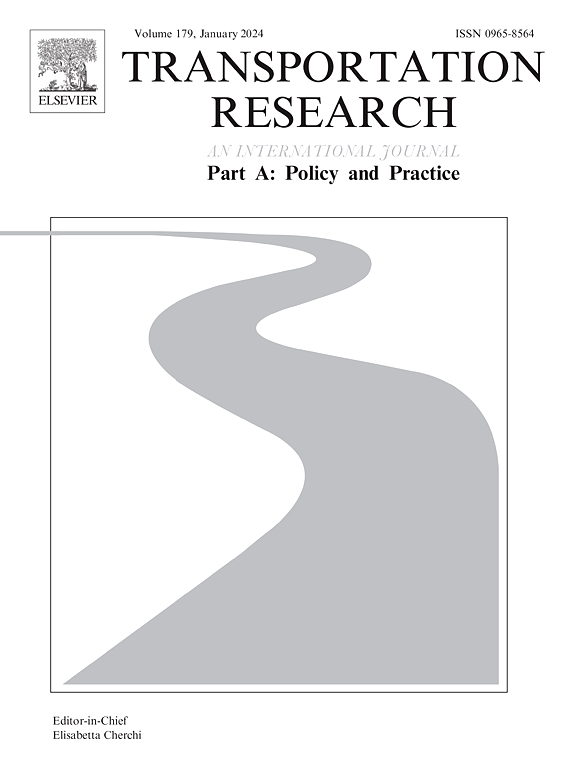IF 6.3
1区 工程技术
Q1 ECONOMICS
Transportation Research Part A-Policy and Practice
Pub Date : 2025-03-24
DOI:10.1016/j.tra.2025.104455
引用次数: 0
摘要
燃料电池重型卡车(FC-HDT)具有更长的续航里程、更短的加油时间和更高的有效载荷,因此具有实现道路货运脱碳的潜力,而政治战略则越来越多地侧重于电池电动重型卡车(BE-HDT)。由于科学文献稀缺,需要进一步开展氢能研究、分析方面的局限性以及缺少投资运输公司的参与,本文采用扩展的社会技术方法对这两种技术进行了比较。要想在历史悠久的系统中实现成功转型,就必须从多维度来看待问题,因此,本文采用 PESTLE 分析法对创新扩散理论进行了扩展,从政治、经济、社会、技术、法律和环境等方面进行了系统研究。为了提供全面的比较和未来的技术指标,本研究将文献综述与 40 个高级专家访谈相结合,尤其关注新的、意想不到的叙述。已发现的机遇和障碍加强了 BE-HDT 的优势,但 FC-HDT 在个别维度和指标上的机遇显示了系统集成的巨大潜力,社会和环境因素为现有科学研究做出了重大贡献。然而,由于氢是去碳化的关键组成部分,政府应重点关注资助动力总成技术的配额制度,以达到广泛部署所需的临界点,并结合有针对性的接受和宣传活动。本文章由计算机程序翻译,如有差异,请以英文原文为准。
Opportunities and barriers of fuel cell heavy-duty trucks: A multi-dimensional comparison with battery-electric heavy-duty trucks
Fuel cell heavy-duty trucks (FC-HDT) have due to their longer range, shorter refuelling time and higher payload the potential to decarbonize road freight transportation, while political strategies are increasingly on battery-electric heavy-duty trucks (BE-HDT). As the scarce scientific literature points to further hydrogen research, limitations in analyzed dimensions and the missing involvement of investing transportation companies, this paper compares the two technologies using an extended socio-technical approach. Successful transitions in long-established systems require a multi-dimensional view, and therefore, the theory of diffusion of innovation is extended with the PESTLE analysis, as political, economic, social, technological, legal, and environmental dimensions allow a systematic research. In order to provide a comprehensive comparison and a future technology indication, this study combines a literature review with 40 high-level expert interviews, paying particular attention to the contribution of new, unexpected narratives. Identified opportunities, and barriers reinforce advantages of BE-HDT, but opportunities of FC-HDT in individual dimensions and indicators show the high potential for system integration, with social and environmental factors contributing significantly to existing scientific research. However, as hydrogen is a key component of decarbonization, government should focus on a quota system for funded powertrain technologies to achieve a required tipping point as critical mass for widespread deployment, combined with targeted acceptance and information campaigns.
求助全文
通过发布文献求助,成功后即可免费获取论文全文。
去求助
来源期刊
CiteScore
13.20
自引率
7.80%
发文量
257
审稿时长
9.8 months
期刊介绍:
Transportation Research: Part A contains papers of general interest in all passenger and freight transportation modes: policy analysis, formulation and evaluation; planning; interaction with the political, socioeconomic and physical environment; design, management and evaluation of transportation systems. Topics are approached from any discipline or perspective: economics, engineering, sociology, psychology, etc. Case studies, survey and expository papers are included, as are articles which contribute to unification of the field, or to an understanding of the comparative aspects of different systems. Papers which assess the scope for technological innovation within a social or political framework are also published. The journal is international, and places equal emphasis on the problems of industrialized and non-industrialized regions.
Part A''s aims and scope are complementary to Transportation Research Part B: Methodological, Part C: Emerging Technologies and Part D: Transport and Environment. Part E: Logistics and Transportation Review. Part F: Traffic Psychology and Behaviour. The complete set forms the most cohesive and comprehensive reference of current research in transportation science.

 求助内容:
求助内容: 应助结果提醒方式:
应助结果提醒方式:


